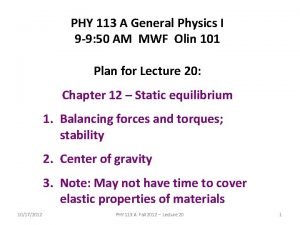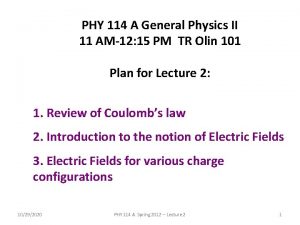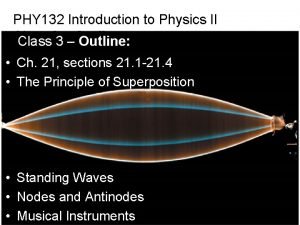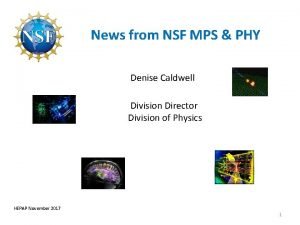Detector RD through the NSF PHY division Jim






- Slides: 6

Detector R&D through the NSF PHY division. Jim Shank/Jim Whitmore, NSF jshank@nsf. gov CPAD Meeting Arlington, TX 5 -7 October, 2015

Physics Division Solicitation. See the full solicitation NSF 15 -579. At the NSF, particle physics is supported by four programs within the Division of Physics: (1) the Theory program, which includes fundamental research on the forces of nature and the early history of the universe as well as support for the experimental program by providing guidance and analysis for high energy experiments; (2) the Elementary Particle Physics (EPP) program, which supports particle physics at accelerators and advances in detector development; (3) the Particle Astrophysics (PA) program, which supports non-accelerator experiments; and (4) the new Accelerator Science program which supports research at universities into the educational and discovery potential of basic accelerator physics. Generic detector development goes to EPP One successful proposal in 2015: Microhexcavity Plasma Panel Detectors for High Energy Physics 10/4/15 2

Particle Astrophysics Program • Cosmic Phenomena: This area supports university research that uses astrophysical sources and particle physics techniques to study fundamental physics. This includes the study of ultra-high energy particles reaching Earth from beyond our atmosphere (cosmic-rays, gamma-rays, and neutrinos with the exception of Ice. Cube); searches for supernova neutrinos; and studies of the Cosmic Microwave Background (CMB) and Dark Energy. • Underground Physics: This area supports university research that generally locates experiments in low background environments. Currently supported activities include: the science of Ice. Cube (searches for ultra-high energy neutrinos and studies of the properties of neutrinos); studies of solar, underground and reactor neutrinos; neutrino mass measurements; and searches for the direct detection of Dark Matter. Specific detector development goes to the PA program; no separate funding One award in 2015: R&D for High Purity Na. I Detectors 10/4/15 3

PHY division proposal preparation(1) • As of last year: All proposals now go through a solicitation (NSF 15 -579 ) Same one for ALL of PHY – Not a Dear Colleague Letter – There are now multiple deadlines (not target dates) • EPP and PA – October 28, 2015 • THY – December 3, 2015 • Accelerator Science (AS) – February 3, 2016 – There additional requirements to be included in Current & Pending (or the Project Description) • If you have multiple sources of support, you must clearly explain how the proposed work is distinct from other funded activities. The proposal review process will include an assessment of the proposers’ ability to carry out the proposed research in light of other commitments. • Also: collaborators in Bio Sketches – Don’t just list “ATLAS collaboration” » List a subset that you work with directly » Can be included in supplementary material so as not to fill up the Bio Sketch 10/4/15 4

PHY division proposal preparation(2) – Letters of Support • Letters of support should not be submitted. • letters of collaboration, limited to stating the intent to collaborate and not containing endorsements or evaluation of the proposed project, are allowed. Letters of collaboration should follow the single-sentence format: – “If the proposal submitted by Dr. [insert the full name of the Principal Investigator] entitled [insert the proposal title] is selected for funding by the NSF, it is my intent to collaborate and/or commit resources as detailed in the Project Description. ” – The Grant Proposal Guide is occasionally updated • Old Timers: You need to read it again • Follow it to the letter, in particular, read: – “Results from Prior NSF Support”, (II. C. 2. d. iii) » This section has changed and many people are not following it correctly • Proposals could be returned without review • PHY Division solicitation 10/4/15 5

Major Research Instrumentation (MRI) • • The Major Research Instrumentation Program (MRI) serves to increase access to shared scientific and engineering instruments for research and research training in our Nation's institutions of higher education, and not-for-profit museums, science centers and scientific/engineering research organizations. This program especially seeks to improve the quality and expand the scope of research and research training in science and engineering, by supporting proposals for shared instrumentation that fosters the integration of research and education in research-intensive learning environments. Two types. – Track (1) acquisition of a research instrument – Track (2) development of a research instrument. • Proposals for $100, 000 -$4 million may be accepted from any MRIeligible organization. • • Present Solicitation 15 -504 Deadline: January 13, 2016 http: //www. nsf. gov/funding/pgm_summ. jsp? pims_id=5260 Program Contact: Kathleen Mc. Cloud or EPP/PA program directors • The MRI program has funded specific detector development, such as the LAr 1 ND TPC 10/4/15 6











